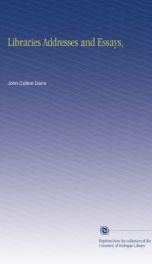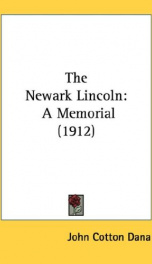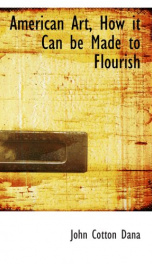Dana John Cotton

John Cotton Dana (b. August 19, 1856 in Woodstock, Vermont — d. July 21, 1929 in New Jersey) was a highly influential American librarian and museum director whose main objective was to make the library relevant to the daily lives of the citizens and to promote the benefits of reading. He was a public librarian for forty years and achieved a great deal in his field. In 1878 Dana graduated from Dartmouth College where he studied law. In 1880 he went to Denver, Colorado where he passed the Colorado bar and began to practice. In 1889 became director of the Denver Public Library until 1898. While there, he pioneered the patron's right to open stacks, allowing them to browse for themselves instead of having a librarian monitoring their every request. He wanted to update libraries into the 20th century by making them vibrant community centers instead of collections of relics that only appealed to a small segment of the community. He also organized the first-ever children's library room. He was personally opposed to the concept of storytime, preferring for his children's library to focus on the continuing education of school teachers. Dana moved to New York where he was admitted to the New York Bar in 1883. In 1885, Dana moved to Minnesota, to take up a position as the editor of the Ashby Avalanche and practice law. Soon after arriving in Minnesota, however, Dana returned again to Colorado to do more surveying and construction work. Because of the reputation he cultivated as a learned man and his connections in the Denver Public Schools, the superintendent of Denver Public Schools, Aaron Gove, nominated Dana as the director of the Denver Public Library upon its inception in 1890. In 1895, Dana left the Colorado Library when the city began discussing the lowering of his salary. Apparently, public controversy had arisen over a city tax levied for the school district and, by extension, the library. Dana also drew criticism for circulating "gold bug" literature at the library. Colorado was economically dependent on mining silver and the gold standard was a political issue. Dana felt that library patrons should have information on both sides of an issue. Back east again, he served as a librarian at the Springfield, Massachusetts public library from 1898 - 1902. He continued many of his Denver policies there. One of the changes Dana implemented at the Springfield library was to the physical building itself. He had workers tear down many of the railings and generally open the floor plan. Although these terms were not invented until nearly a century later, Dana concerned himself heavily with the ergonomics and usability of his collections and facilities. He left Springfield after refusing to become involved in a power struggle with the library's patrons. In 1902 Dana became employed at the Newark Public Library in Newark, New Jersey from until his death in 1929. He established foreign language collections for immigrants and also developed a special collection for the business community. This "Business Branch" was the first of its kind in the nation. He also founded the Newark Museum in 1909, directing it until his death. The Museum was exceptional because it included contemporary American commercial products as folk art. John C. Dana personally did not like modern art, but he believed in the principle of a universal museum and thus ordered purchases of art associated with the Ashcan School. Cotton also began the Newark Museum's notable Tibetan collection. After his death, his successor at the Newark Public Library referred to him as “The First Citizen of Newark”. Six years after his death, the city of Newark appointed October 6, 1935 as John Cotton Dana Day. Rutgers-Newark's main library is named for John Cotton Dana. Dana was quoted as saying, “A great department store, easily reached, open at all hours, is more like a good museum of art than any of the museums we have yet established” (Hadley, 68). Dana served as president of the American Library Association, which today gives out the John Cotton Dana Public Relations Award to libraries with exceptional public relations.[1] The NJ Associations of Museums has an annual award in his name, presented to an individual "for outstanding contributions to the New Jersey museum profession." John Cotton Dana was also the first president and founder of the Special Libraries Association. Dana is a member of the Library Hall of Fame. Also, New Jersey Law School renamed their college Dana College when it transitioned from a two year to a four year school (Watkins 2006, 2). John Cotton Dana married, but his wife (Adine Rowena Wagener), whom he married in 1888 was not healthy, and they had no children. One of his biographers said of him, “He would have found a library school curriculum intolerable, and doubtless a library school would have found him intolerable” (Hadley, 12).
do you like this author?
What readers are saying
What do you think? Write your own comment on this book!
write a commentWhat readers are saying
What do you think? Write your own comment on this author!
write a commentBook list

the pomfret library vermont in the abbott memorial library building
Series:
Unknown
Year:
Unknown
Raiting:
3/5
This volume is produced from digital images created through the University of Michigan University Library's preservation reformatting program. The Library seeks to preserve the intellectual content of items in a manner that facilitates and promotes a variety of uses. The digital reformatting process results in an electronic version of the text that can both be accessed online and used to create new print copies. This book and thousands of others can be found in the digital collections of the University of Michigan Library. The University Library also understands and values the utility of print, and makes reprints available through its Scholarly Publishing Office. --This text refers to an alternate Paperback edition.
Show more
add to favoritesadd In favorites
Book list

the pomfret library vermont in the abbott memorial library building
Series:
Unknown
Year:
Unknown
Raiting:
3/5
This volume is produced from digital images created through the University of Michigan University Library's preservation reformatting program. The Library seeks to preserve the intellectual content of items in a manner that facilitates and promotes a variety of uses. The digital reformatting process results in an electronic version of the text that can both be accessed online and used to create new print copies. This book and thousands of others can be found in the digital collections of the University of Michigan Library. The University Library also understands and values the utility of print, and makes reprints available through its Scholarly Publishing Office. --This text refers to an alternate Paperback edition.
Show more
add to favoritesadd In favorites

on buying and using print practical suggestions from a librarian to the busines
Series:
Unknown
Year:
Unknown
Raiting:
4/5
Show more
add to favoritesadd In favorites

notes on bookbinding for libraries
Series:
Unknown
Year:
Unknown
Raiting:
3.5/5
Naud6 On Binding"The fourth is, to retrench & cut off all the superfluous expences, which manv orodieaUv and to no ouroose bestow upon the binding and ornaments of their Books, and to employ it in purchasing such as they want, that so they may not be obnoxious to that * censure of Seneca, who hand-somlv reproaches those, Quibus volumintim suorum frontes maxime placent titulique; & this the rather, that the binding is nothing but an accident & form of appearing, without which (at least so splendid and sumptuous) Books become altogether as useful, commode & rare; it becoming the ignorant onelv to esteem a Book for its cover; seeing it is not with Books, as it is with men, who are onely known and respected for their robes and their clothes, so that it is a great deal better, and more necessary, for example, to have a good quantity of Books, well & ordinarily bound, than to have a little Chamber or Cabinet full of washed, gilded, ruled, and enriched with all manner of nicity, lux and suAbout the Publisher Forgotten Books is a publisher of historical writings, such as: Philosophy, Classics, Science, Religion, History, Folklore and Mythology.Forgotten Books' Classic Reprint Series utilizes the latest technology to regenerate facsimiles of historically important writings. Careful attention has been made to accurately preserve the original format of each page whilst digitally enhancing the difficult to read text. Read books online for free at www.forgottenbooks.org
Show more
add to favoritesadd In favorites

libraries addresses and essays
Series:
Unknown
Year:
Unknown
Raiting:
5/5
This volume is produced from digital images created through the University of Michigan University Library's preservation reformatting program. The Library seeks to preserve the intellectual content of items in a manner that facilitates and promotes a variety of uses. The digital reformatting process results in an electronic version of the text that can both be accessed online and used to create new print copies. This book and thousands of others can be found in the digital collections of the University of Michigan Library. The University Library also understands and values the utility of print, and makes reprints available through its Scholarly Publishing Office.
Show more
add to favoritesadd In favorites
What readers are saying
What do you think? Write your own comment on this author!
write a commentif you like Dana John Cotton try:
readers also enjoyed
What readers are saying
What do you think? Write your own comment on this author!
write a commentGenre
if you like Dana John Cotton try:
readers also enjoyed
Do you want to exchange books? It’s EASY!
Get registered and find other users who want to give their favourite books to good hands!




